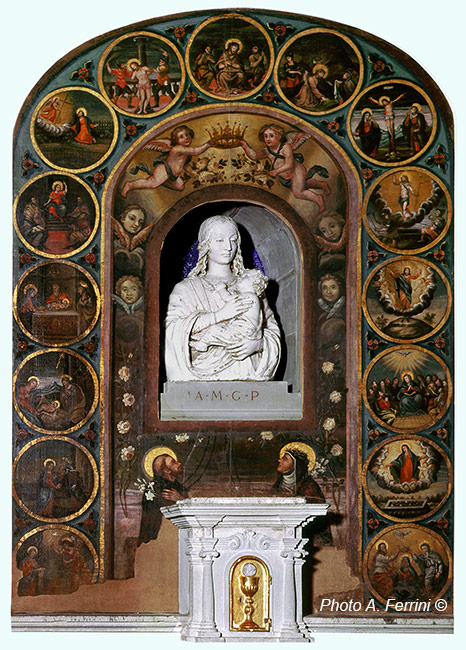Carda
in Casentino, una bella valle Toscana che puoi conoscere in ogni suo dettaglio con questo sito
Italiano
UNA CORNICE PER LA MADONNA
Nel 1615 il parroco di Carda Don Domenico Mascalchi commissionò al pittore aretino Sebastiano Pontenani quest'opera che doveva essere una sorta di grande ed elegante cornice per la Madonna con Bambino di scuola robbiana arrivata a Carda nel 1554. Lo scopo del sacerdote era probabilmente quello di creare una Madonna del Rosario nella Chiesa di Carda per onorare la locale Compagnia del Santo Rosario.
Nel '600 il tema "Madonna del Rosario" era molto sfruttato da pittori più o meno noti. La rappresentazione classica era la Vergine con Bambino che dona il rosario a San Domenico contornata da altri Santi con Santa Caterina da Siena quasi sempre presente. Qualche volta, a contorno della scena, erano raffigurati i quindici Misteri del Rosario.
Qui a Carda un'elegante e preziosa Madonna con Bambino (anche se senza rosario) c'era già. A Sebastiano Pontenani fu quindi commissionato di dipingere su questa tavola centinata, e con foro centrale della misura esatta per accoglier la Vergine, i quindici Misteri del Rosario. Sopra il foro, in modo che apparissero sopra la testa della Vergine, due angeli nell'atto d'incoronarla. Sotto la Madonna, semicoperti dal ciborio, sono raffigurati San Lorenzo e Santa Caterina da Siena.
I quindici Misteri del Rosario, nell'opera di Carda come in tutte le altre, mostrano queste scene: l'Annunciazione, la visita di Maria alla cugina Elisabetta, la natività di Gesù, la presentazione di Gesù al Tempio, Gesù nel tempio tra i dottori, Gesù nell'orto degli olivi, Gesù flagellato alla colonna, Gesù deriso e incoronato con spini, Gesù che cade sotto il peso della croce, la morte di Gesù sulla croce, la Resurrezione di Gesù, ascensione di Gesù, discesa dello Spirito Santo su Maria e gli apostoli (Pentecoste), l'assunzione di Maria in cielo, Maria incoronata regina.
In 1615 the parish priest of Carda Don Domenico Mascalchi commissioned the Arezzo painter Sebastiano Pontenani to create this work, which was to be a sort of large and elegant frame for the Madonna with Child of the Robbian school that arrived in Carda in 1554. The priest's aim was probably to create a Madonna of the Rosary in the Church of Carda to honour the local Company of the Holy Rosary.
In the 17th century the theme of the "Madonna of the Rosary" was widely used by more or less well-known painters. The classic representation was the Virgin with Child giving the rosary to Saint Dominic surrounded by other Saints with Saint Catherine of Siena almost always present. Sometimes, the fifteen Mysteries of the Rosary were depicted around the scene.
Here in Carda an elegant and precious Madonna with Child (although without a rosary) already existed. Sebastiano Pontenani was then commissioned to paint the fifteen Mysteries of the Rosary on this arched panel, with a central hole of the exact size to accommodate the Virgin. Above the hole, so that they appeared above the head of the Virgin, two angels in the act of crowning her. Under the Madonna, half-covered by the ciborium, are depicted Saint Lawrence and Saint Catherine of Siena. The fifteen Mysteries of the Rosary, in Carda's work as in all the others, show these scenes: the Annunciation, Mary's visit to her cousin Elizabeth, the birth of Jesus, the presentation of Jesus at the Temple, Jesus in the temple among the doctors, Jesus in the garden of olives, Jesus scourged at the column, Jesus mocked and crowned with thorns, Jesus falling under the weight of the cross, the death of Jesus on the cross, the Resurrection of Jesus, the ascension of Jesus, the descent of the Holy Spirit on Mary and the apostles (Pentecost), the assumption of Mary into heaven, Mary crowned queen.

















































